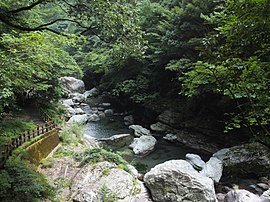Niyodogawa
Niyodogawa
仁淀川町 | |
|---|---|
 Niyodogawa Town Hall | |
 Location of Niyodogawa in Kōchi Prefecture | |
 | |
| Coordinates: 33°35′N 133°10′E / 33.583°N 133.167°E | |
| Country | Japan |
| Region | Shikoku |
| Prefecture | Kōchi |
| District | Agawa |
| Area | |
• Total | 333.00 km2 (128.57 sq mi) |
| Population (August 1, 2022) | |
• Total | 4,861 |
| • Density | 15/km2 (38/sq mi) |
| Time zone | UTC+09:00 (JST) |
| City hall address | 200 Osaki, Niyodogawa-chō, Agawa-gun, Kōchi-ken 781-1592 |
| Website | Official website |


Niyodogawa (仁淀川町, Niyodogawa-chō) is a town located in Agawa District, Kōchi Prefecture, Japan. As of 1 August 2022[update], the town had an estimated population of 4‚861 in 2788 households and a population density of 15 persons per km².[1]The total area of the town is 333.0 square kilometres (128.6 sq mi).
Geography
Niyodogawa is located in the Shikoku Mountains of north-central Kōchi Prefecture on the upper reaches of the Niyodo River.
Neighbouring municipalities
Kōchi Prefecture
Ehime Prefecture
Climate
Nahari has a Humid subtropical climate (Köppen Cfa) characterized by warm summers and cool winters with light snowfall. The average annual temperature in Nahari is 13.3 °C. The average annual rainfall is 2688 mm with September as the wettest month. The temperatures are highest on average in January, at around 24.1 °C, and lowest in January, at around 2.1 °C.[2]
Demographics
Per Japanese census data,[3] the population of Niyodogawa has been decreased steadily precipitously since the 1950s an dis now less than a third of what it was a century ago.
| Year | Pop. | ±% |
|---|---|---|
| 1920 | 22,503 | — |
| 1930 | 23,063 | +2.5% |
| 1940 | 24,479 | +6.1% |
| 1950 | 26,067 | +6.5% |
| 1960 | 20,783 | −20.3% |
| 1970 | 13,736 | −33.9% |
| 1980 | 11,672 | −15.0% |
| 1990 | 9,518 | −18.5% |
| 2000 | 8,189 | −14.0% |
| 2010 | 6,502 | −20.6% |
History
As with all of Kōchi Prefecture, the area of Niyodogawa was part of ancient Tosa Province. During the Edo period, the area was part of the holdings of Tosa Domain ruled by the Yamauchi clan from their seat at Kōchi Castle. Following the Meiji restoration, the village of Ikegawa was established within Agawa District, Kōchi with the creation of the modern municipalities system on October 1, 1889. Ikegawa was raised to town status on April 1, 1913. On August 1, 2005 the town of Ikegawa, the village of Agawa, both from Agawa District, and the village of Niyodo, from Takaoka District were merged to form the town of Niyodogawa.
Government
Niyodogawa has a mayor-council form of government with a directly elected mayor and a unicameral town council of five members. Niyodogawa, together with the municipalities of Agawa District, contributes two members to the Kōchi Prefectural Assembly. In terms of national politics, the town is part of Kōchi 2nd district of the lower house of the Diet of Japan.
Economy
Traditionally, agriculture, forestry and limestone mining were mainstays of the local economy. The area is noted for its production of Tosa Tea, a variety of green tea.
Education
Niyodogawa has three public elementary schools and two public middle schools operated by the town government. The town does not have a high school
Transportation
Railway
The town does not have any passenger railway service. The nearest train station is Ino Station or Sakawa Station on the JR Shikoku Dosan Line.
Highways
Local attractions
The most popular festival held in Niyodogawa is the Akiba Matsuri, held annually on February 11. A day long procession up a hillside to the Akiba Jinja, it features elaborate costumes, a highly choreographed march and focuses on the tossing of long wooden poles topped with the tail feathers of Onagadori, the famous long tailed roosters of Kōchi Prefecture. Often designated as one of the three major festivals in the Kōchi festival calendar, it is the one occasion where many former residents of the town return to participate, particularly important for a small town ravaged by depopulation.
References
- ^ "Niyodogawa town official statistics" (in Japanese). Japan.
- ^ Nahari climate data
- ^ Niyodogawa population statistics
External links
 Media related to Niyodogawa, Kōchi at Wikimedia Commons
Media related to Niyodogawa, Kōchi at Wikimedia Commons- Niyodogawa official website (in Japanese)



